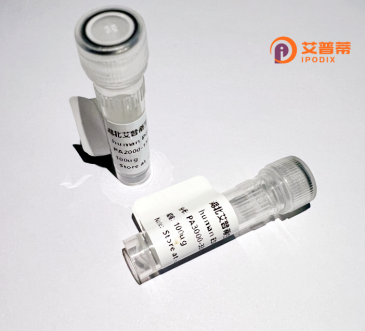
| 纯度 | >90%SDS-PAGE. |
| 种属 | Human |
| 靶点 | ZNF408 |
| Uniprot No | Q9H9D4 |
| 内毒素 | < 0.01EU/μg |
| 表达宿主 | E.coli |
| 表达区间 | 1-720 aa |
| 活性数据 | MEEAEELLLE GKKALQLARE PRLGLDLGWN PSGEGCTQGL KDVPPEPTRD ILALKSLPRG LALGPSLAKE QRLGVWCVGD PLQPGLLWGP LEEESASKEK GEGVKPRQEE NLSLGPWGDV CACEQSSGWT SLVQRGRLES EGNVAPVRIS ERLHLQVYQL VLPGSELLLW PQPSSEGPSL TQPGLDKEAA VAVVTEVESA VQQEVASPGE DAAEPCIDPG SQSPSGIQAE NMVSPGLKFP TQDRISKDSQ PLGPLLQDGD VDEECPAQAQ MPPELQSNSA TQQDPDGSGA SFSSSARGTQ PHGYLAKKLH SPSDQCPPRA KTPEPGAQQS GFPTLSRSPP GPAGSSPKQG RRYRCGECGK AFLQLCHLKK HAFVHTGHKP FLCTECGKSY SSEESFKAHM LGHRGVRPFP CPQCDKAYGT QRDLKEHQVV HSGARPFACD QCGKAFARRP SLRLHRKTHQ VPAAPAPCPC PVCGRPLANQ GSLRNHMRLH TGEKPFLCPH CGRAFRQRGN LRGHLRLHTG ERPYRCPHCA DAFPQLPELR RHLISHTGEA HLCPVCGKAL RDPHTLRAHE RLHSGERPFP CPQCGRAYTL ATKLRRHLKS HLEDKPYRCP TCGMGYTLPQ SLRRHQLSHR PEAPCSPPSV PSAASEPTVV LLQAEPQLLD THREEEVSPA RDVVEVTISE SQEKCFVVPE EPDAAPSLVL IHKDMGLGAW AEVVEVEMGT |
| 分子量 | 78.4 kDa |
| 蛋白标签 | His tag N-Terminus |
| 缓冲液 | PBS, pH7.4, containing 0.01% SKL, 1mM DTT, 5% Trehalose and Proclin300. |
| 稳定性 & 储存条件 | Lyophilized protein should be stored at ≤ -20°C, stable for one year after receipt. Reconstituted protein solution can be stored at 2-8°C for 2-7 days. Aliquots of reconstituted samples are stable at ≤ -20°C for 3 months. |
| 复溶 | Always centrifuge tubes before opening.Do not mix by vortex or pipetting. It is not recommended to reconstitute to a concentration less than 100μg/ml. Dissolve the lyophilized protein in distilled water. Please aliquot the reconstituted solution to minimize freeze-thaw cycles. |
以下是关于重组人ZNF408蛋白的3篇参考文献的简要总结:
---
1. **文献名称**:**"Structural and Functional Analysis of ZNF408. a Krüppel-associated Box Zinc Finger Protein Involved in Neovascularization"**
**作者**:Li Y. et al.
**摘要**:该研究解析了重组人ZNF408蛋白的结构,发现其KRAB结构域和锌指模体在调控血管内皮生长因子(VEGF)信号通路中的作用,揭示了ZNF408通过结合特定DNA序列促进视网膜血管新生的分子机制。
---
2. **文献名称**:**"ZNF408 Regulates EXOC5 Expression and Mediates Angiogenesis via Exosome Signaling"**
**作者**:Wang X. et al.
**摘要**:研究团队利用重组ZNF408蛋白进行功能实验,证明其通过调控EXOC5基因表达,影响内皮细胞外泌体的释放,从而在缺血性心血管疾病模型中促进血管生成和修复。
---
3. **文献名称**:**"A novel mutation in ZNF408 causes familial exudative vitreoretinopathy through disrupted protein-DNA binding"**
**作者**:Collin R.W.J. et al.
**摘要**:该文献通过构建重组突变型ZNF408蛋白,发现其DNA结合能力显著降低,导致家族性渗出性玻璃体视网膜病变(FEVR)患者中血管发育异常,为疾病机制提供了分子层面的解释。
---
*注:若需具体文献来源,建议通过PubMed或Sci-Hub输入标题或作者检索全文。*
Zinc Finger Protein 408 (ZNF408) is a member of the C2H2-type zinc finger family, characterized by conserved zinc-binding domains that enable sequence-specific DNA or RNA interactions. Predominantly expressed in vascular and retinal tissues, ZNF408 functions as a transcription regulator, influencing genes involved in angiogenesis, extracellular matrix remodeling, and vascular integrity. Notably, it directly binds to promoters of collagen genes like *COL4A1* and *COL4A2*, critical for basement membrane stability. Mutations in *ZNF408* are linked to familial exudative vitreoretinopathy (FEVR) and diabetic retinopathy, where dysregulated vasculature leads to vision impairment. Structurally, it features an N-terminal region of unknown function and a C-terminal zinc finger cluster mediating DNA recognition. Recombinant human ZNF408 protein, typically produced in *E. coli* or mammalian expression systems, serves as a vital tool for *in vitro* studies, including DNA-binding assays (e.g., EMSA), transcriptional activity analyses, and interaction mapping with co-regulators. Its role in pathological neovascularization also positions it as a potential therapeutic target for retinal diseases. Ongoing research explores its broader implications in developmental and inflammatory pathways, underscoring its multifaceted regulatory capacity.
×